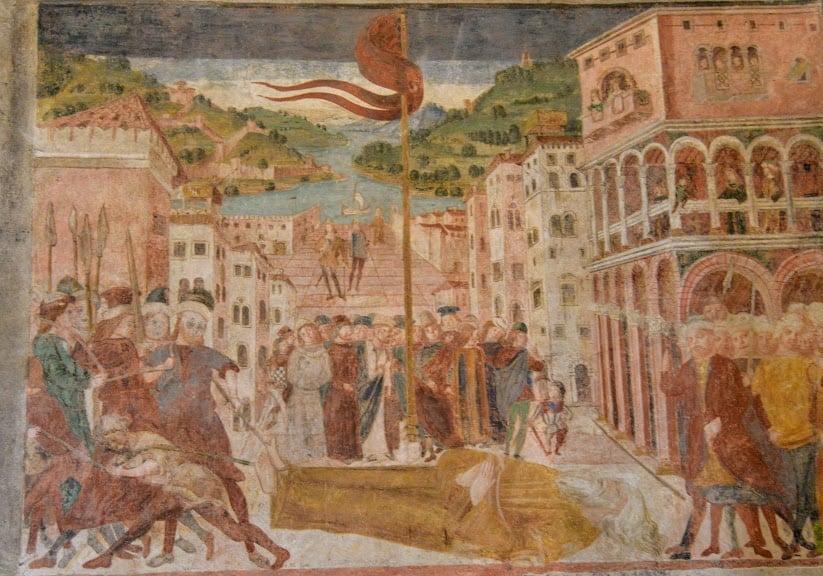SANT’ANDREA IN BIGONZO – VITTORIO VENETO. Talking about a church like that of Sant’Andrea in Bigonzo in Vittorio Veneto is not easy. The oldest of the churches of the city in fact preserves inside a quantity of frescoes of great value and quality, ferried to the present day in a legible and usable way to the visitor thanks to the various restoration interventions that over the centuries have preserved their freshness and readability. The hands are many, the authors different. All however included between the fifteenth and sixteenth centuries. Impossible not to mention two parishes, because it is a parish church, which strongly supported the realization of many of the present works in the fifteenth century. Benedetto Cesana and his successor Holy Lebanon. He, it seems, to commemorate his predecessor had the two frescoes painted that are immediately to the right of the visitor entering the main door. The Mass of San Gregorio and San Michele Arcangelo respond to a devotion and suffrage of the dead. The Mass of St. Gregory escapes the usual interpretation that is given of the episode that saw the Pope protagonist, during the Mass of a miraculous phenomenon. The texts narrate that St. Gregory saw the crucified Christ during the solemn moment of the rising of the host, and the iconographic representations of the event refer to this episode. The unprecedented interpretation in this church represents him kneeling on the altar where bread and wine are placed, evokes the deposition of Christ in the tomb, perhaps to give the fresco a location that distinguishes it from all the others. Mary and St. John support the Body of Christ emerging from the sarcophagus. The face of St. John is repeated in that of St. Michael the Archangel and the date is that of 1487. St. Jerome is then represented in two episodes, again on the right wall, in which in one he is painted in the guise of Father of the Church, accompanied by S. Sebastian, in the other he “transforms” into a penitent hermit who hits his chest with a huge stone at the foot of the Cross, while on the right, S. Brigida pours burning wax on her chest, perhaps to simulate the suffering of wounds on the side of Christ. On the left wall we can see a fresco depicting the Madonna and Child enthroned. San Rocco (with dog) John the Baptist to the right of the Virgin. To the left of him Sant’Andrea and San Bernardino da Siena. The Veneranda Scuola dei Battuti di Serravalle called Antonio Zago in the early sixteenth century to decorate their chapel, located to the left of the presbytery. The intervention included the perimeter walls, the cross sails and the arches on both fronts. The chapel is dedicated to Saint Andrew and retraces all the stages of his life up to his martyrdom on the Cross. The story unfolds from top to bottom in three distinct moments. The first scene on the top left represents the call of Saint Andrew by Jesus while the Saint is fishing. Two salient episodes immediately below. In one, the Angel of the Lord who orders him to go to Ethiopia by boat, and in the other the Saint, having arrived at a prison, finds Matthew and heals him of blindness. The larger scene below at the height of the viewer shows us Saint Andrew tied up and dragged into the square by his executioners. The Saint appears as rigid as a marble column but a serenity shines through his face which contrasts with the ferocious expressions of his tormentors for whom he asks forgiveness. The story continues with the vision of the cross and the crucifixion of the saint. Looking up, in the sails of the cross vault we recognize the four Doctors of the Church and the symbols of the four Evangelists (Tetramorph) with a background of medieval plants.
One of the frescoes that visitors really like and for its liveliness of colors and the meaning it conveys is undoubtedly one of the most popular is on the right wall. Three Saints. In the center Job who contrasts with his nakedness with the other two Saints at his side, heavily dressed. Sant’Antonio Abate with fire in his hand that refers to herpes zoster commonly known as the “Fire of Sant’Antonio” and San Rocco showing the bubo contracted during his dedication to the plague victims, from which he miraculously recovered. I stop here so as not to tire the reader too much to whom I recommend a visit to this parish which, full of meditative ideas, offers those who come to know it some moments of art that are hard to forget. Another discovery, a pearl in the treasure of the churches, large and small, parish churches and oratories that dot our territory. True chests of treasures of Sacred Art that must be opened and rediscovered, valued and protected for the great message that they bring us from the past and give us ideas to renew faith in our deep Christian roots through a visual language understandable to all and which everyone is addressed with great simplicity thanks to the skilled hands of the great artists of the past
Pio Dal Cin
(Photo Pio Dal Cin)
.






